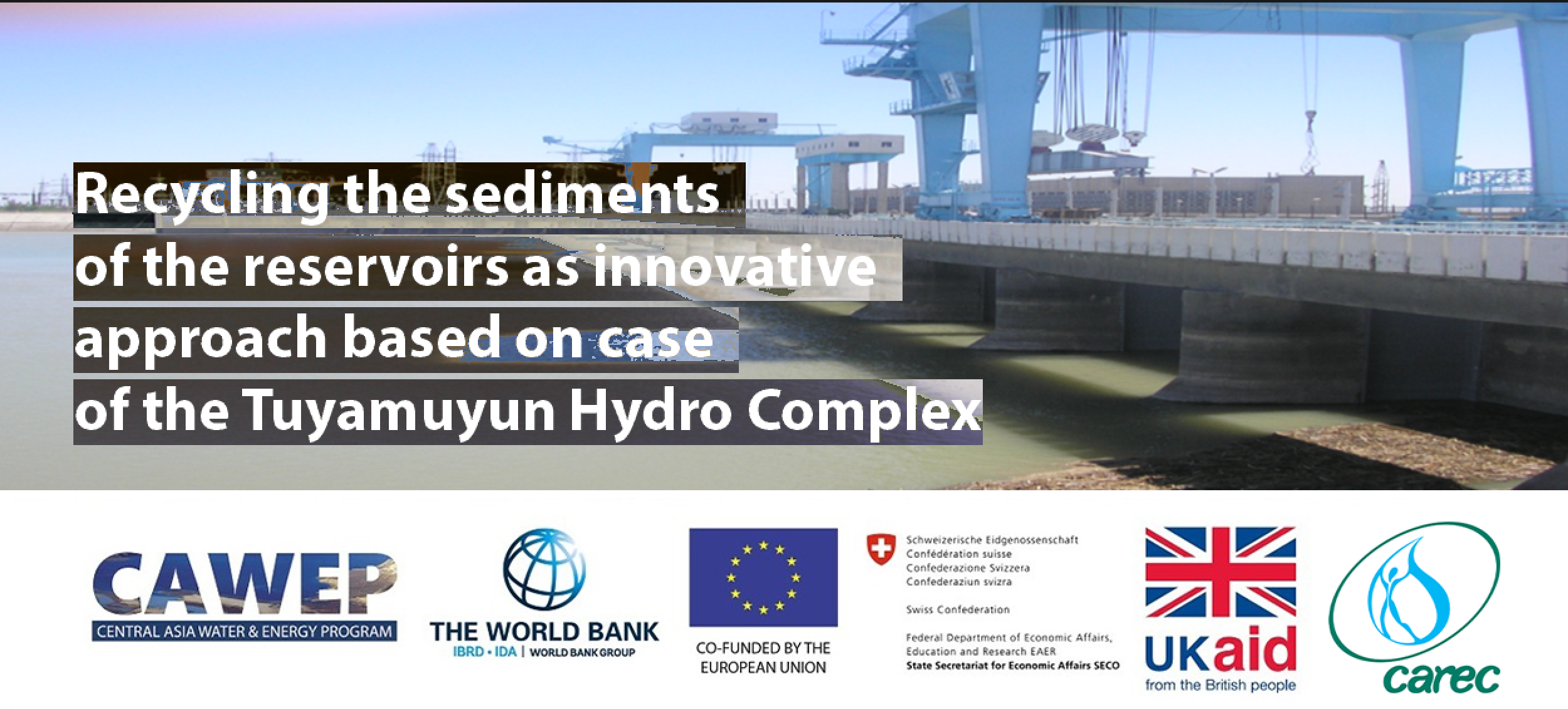
Recycling the sediments of the reservoirs as innovative approach based on case of the Tuyamuyun Hydro Complex
CAWEPBackground
Reservoirs represent one of the most efficient means of ensuring water supply via active regu-lation (management) and re-distribution of river runoff over time for use in different economic sectors. Today, Uzbekistan is operating over 50 large and numerous small reservoirs, mainly for irrigation. The total volume of regulated runoff amounts to 21 km3 or about 40% of the total available water resources consumed annually by all the sectors of the national economy.
From the hydrological point of view, reservoirs form relatively quickly and do not render suf-ficient time for the environment as well as rivers’ natural hydrological regime to adapt. The flow regime in reservoirs is sophisticated. Runoff flows can be well traced in reservoir transi-ent zones and upper sections, mainly in flooded main river channels. In the near-dam section, drain currents form as a result of idle water discharge into the tail bay through spillways, through culverts into HPP channels and/or turbines. Water flow dynamics inside reservoirs, current directions, as well as water stream speed arise under the influence of gravity, pressure gradients and friction stress. The distribution of such currents in reservoirs is accompanied by the transfer of suspended and bed sediments, sediment accumulation and scours, i.e. erosion sites in the reservoir basin and coastline alteration.
As currents spread, the dynamic processes inside a reservoir depend on its morphological fea-tures, i.e. bed slope, depth, water exchange rate, etc. In lowland reservoirs, the interaction between bottom and surface wave currents manifests itself rather aggressively. Since the mechanisms underpinning the development of such currents remain largely uncertain, numer-ous experimental and theoretical studies are ongoing to investigate the matter. The theory of runoff regulation has recently become a powerful tool for justifying water management at var-ious levels, although many challenges still require a more detailed inquiry.
At the 1st Regional Steering Committee Meeting (October 27, 2020) , the Ministry of Water Resources (MWR) of the Republic of Uzbekistan (RUz) and Turkmenistan’s State Committee for Water Resources (TM SCWR) proposed the Tuyamuyun Hydro Complex (TMHC) as the demonstration project site within the framework of the European Union’s Central Asia Nexus Dialogue Project: Fostering Water, Energy and Food Security Nexus and Multi-Sector In-vestment (Phase II). This demo project aimed to assess the sedimentation in the Ruslovoye Reservoir at the TMHC leading to its reduced active (useful) capacity. Sediment accumula-tion in the Ruslovoye Reservoir curbs the operation of the offstream reservoirs (Sultansanjar, Koshbulak, and Kaparas) covering Uzbekistan’s and Turkmenistan’s irrigation needs.
Project goal: conduct measurements and assess sedimentation scale at the Ruslovoye Reser-voir of the Tuyamuyun Hydro Complex; carry out sedimentation forecast calculations and elaborate recommendations for optimizing the reservoir’s operation regimes to diminish sedi-mentation based on innovative solutions in terms of utilizing sediment deposit materials.
To achieve the project goal, the following tasks were completed: investigating the river bed and irrigation canal condition in the Amu Darya River lower reaches over the years of TMHC op-eration; analyzing the main performance indicators of the TMHC reservoirs for the years of operation, and evaluating the TMHC overall performance; assessing the influence of reservoir operation regimes on non-productive water losses; diagnosing the effect of irrigation-related deposits on farmland productivity in the downstream Amu Darya.
In broad terms, the exercise aimed at designing and proposing enhanced operation regimes for the TMHC reservoir system to eliminate the negative consequences of disrupted natural chan-nel regime of the lower Amu Darya River, including to improve water intake into irrigation canals, bring down filtration water losses, as well as boost agricultural productivity.
Disclaimer
This work was produced under the European Union funded project “Central Asia Nexus Dialogue Project: Fostering Water, Energy and Food Security Nexus and Multi-Sector Investment (Phase II)” implemented by the Regional Environmental Center for Central Asia (CAREC) and the financial support of the project “Laboratory of Innovative Solutions for the Water Sector of Central Asia” under the Central Asia Water and Energy Program (CAWEP). Its contents are the sole responsibility of authors and do not necessarily reflect the views of the European Union, CAWEP and CAREC.
Full technical details and findings on the TCH case can be found at this link NexusPhase2
